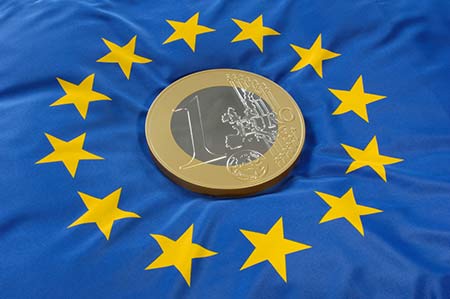The Euro weakened against the Pound to fall back to a one-and-a-half year low after data released on Monday raised concerns that the Eurozone recovery is slowing.
Purchasing Managers Index data for the Eurozone’s manufacturing and services sectors fell in June with France leading the way in terms of declines. According to Markit the Eurozone’s composite PMI which is comprised of both manufacturing and service sector activity tumbled to a six-month low this month to a figure of 52.8, a fall from May’s figure of 53.5.
Individually the regions manufacturing Index dropped to 51.9, down from the previous month’s final reading of 52.2. Economists had been forecasting for an unchanged figure. Services also fell to 52.8 in June, a drop from the previous months figure of 53.2.
The Euro to Pound Exchange Rate is at 0.7977
The disappointing data adds to concerns that the Eurozone recovery is stalling. Last week the International Monetary Fund said that the recovery was struggling to find momentum, the body also painted a grim assessment of the economy as a whole.
“The June PMI rounded off the strongest quarter for three years, but a concern is that a second consecutive monthly fall in the index signals that the Eurozone recovery is losing momentum. The big concern is once again the divergent trends within the Eurozone. Although the survey suggests the Eurozone as a whole should grow by at least 0.4% in the second quarter, France appears to be entering a renewed downturn after GDP stagnated in the first quarter.
‘Germany meanwhile looks set to grow by 0.7% or more in the second quarter, albeit with signs that the upturn is starting to lose momentum again. It is the rest of the region, outside of France and Germany, which – as a whole – is seeing the strongest growth momentum at the moment, highlighting how the “periphery‟ is recovering. Growth outside of France and Germany accelerated in June to round off the best quarter since the third quarter of 2007,” said Markit’s Chris Williamson.
Germany’s manufacturing PMI increased to a two month high of 52.4 in June, up from the previous months figure of 52.3. The nation’s services sector however fell to a two-month low but remained well above the level that divides expansion from contraction.
France is the big worry however as it continues to under perform. The nation’s manufacturing PMI fell to a six-month low and its services PMI dropped to a four-month low.
“Given that real GDP stagnated in the first quarter–propped up by government spending–and that a host of indicators point to continuing weakness in the private sector, there is now a real prospect that the economy contracted in the second quarter, and that a return to solid growth remains some distance off. A stabilisation of new business levels in the French services sector provides some reassurance, but on almost every other sub-component the PMI paints a picture of an economy in trouble,” said Aengus Collins, Europe analyst at the Economist intelligence unit.
With no market moving data due again until later in the week the Pound is forecast to remain higher against the Euro. Thursday sees the release of the latest UK current account and GDP data. Friday will see the publication of the latest Eurozone confidence reports. Sentiment is likely to show a fall across the board as concerns over a weakening economy and events in Ukraine and Iraq soften confidence.
Euro to USD
The Euro fell further against the US Dollar on Monday after data released in the USA showed that the recovery in the world’s largest economy is gaining momentum.
Data released by Markit showed that it’s flash US Manufacturing PMI rose to 57.5 in June, beating economist forecasts for a figure of 56.5 and was the highest reading recorded since May 2010. According to the data the output sub index advanced to 61 from 59.6 while new orders climbed to 61.7, up from May’s final reading of 58.8. Both marked the highest level for the indexes since April 2010.
Also buoying the ‘Greenback’ was a separate report which showed that the existing home sales in the US climbed by 4.9% in April, the highest increase seen in seven months.
“The data adds to indications that the US economy rebounded strongly in the second quarter from the weather related weakness seen at the start of the year,” said Markit’s chief economist Chris Williamson.
The US data further highlights the diverging economies of the USA and Eurozone. Whilst one strengthens the other one falters.
Euro Exchange Rate News:
[table width=”100%” colwidth=”50|50|50|50|50″ colalign=”left|left|left|left|left”]
Currency, ,Currency,Rate ,
Euro, ,US Dollar,1.3581 ,
,US Dollar,1.3581 ,
Euro, ,British Pound,0.7977 ,
,British Pound,0.7977 ,
Euro, ,Australian Dollar,1.4398 ,
,Australian Dollar,1.4398 ,
Euro, ,Canadian Dollar,1.4570 ,
,Canadian Dollar,1.4570 ,
British Pound, ,Euro,1.2534 ,
,Euro,1.2534 ,
[/table]



